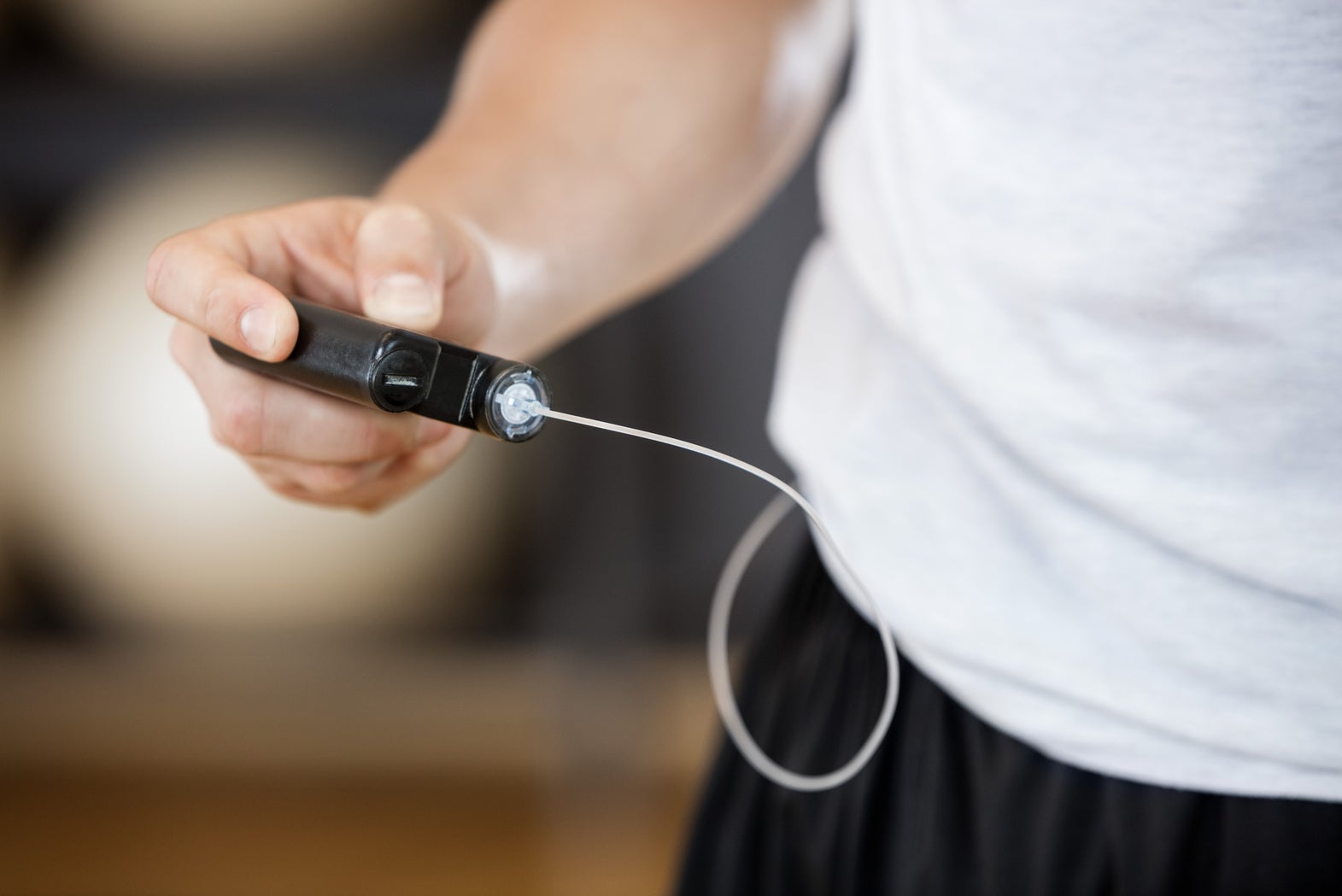
The wearable tech market is currently worth over $50bn, having more than doubled in size since 2014. Even after the hype around wearable tech peaked between 2014 and 2015, the industry has continued to grow between 10-20% each year.
Growth in the market has been concentrated around headphones and augmented and virtual reality headsets, as well as medical devices like hearing aids and glucose monitoring devices.
The healthcare sector of the wearable industry is expected to see continued growth. GlobalData has predicted that the market will double from $23bn in 2018 to $54bn in 2023.
Innovation has grown most prominently in the context of the smartwatch, with certain wrist-wearables even achieving limited status as medical devices. The Apple Watch 4 has received US Food and Drug Administration (FDA) clearance for three heart monitoring capabilities: low heart rate, heart rhythm detection, and a personal electrocardiogram (ECG) monitor.
But when it comes to blood pressure monitoring, everyday wearables have struggled – and it’s something which many people with hypertension may need to check in on several times a day.
Plenty of wristwatch wearables on the market now claim they’re able measure blood pressure, but it’s an incredibly sensitive metric that is much harder to track through a wristband than heart rate or rhythm.
How well do you really know your competitors?
Access the most comprehensive Company Profiles on the market, powered by GlobalData. Save hours of research. Gain competitive edge.

Thank you!
Your download email will arrive shortly
Not ready to buy yet? Download a free sample
We are confident about the unique quality of our Company Profiles. However, we want you to make the most beneficial decision for your business, so we offer a free sample that you can download by submitting the below form
By GlobalDataThe majority of wristwatches which monitor heart rate, like the Samsung Galaxy Active, use optical sensors to do so. Optical sensors estimate changes in blood pressure by looking at the volume of blood travelling through a vein, which will increase if pressure increases. This can provide an approximation of blood pressure, but it can’t match the accuracy of an oscillometric machine used in a doctor’s surgery.
Making wearables for the sake of making wearables
At present the only FDA approved, CE (a certification signalling that a product meets Europe’s health and safety laws) marked device of this nature is the Omron HeartGuide.
This smartwatch has an inflatable blood pressure monitor embedded inside the cuff, which expands and tightens to take a blood pressure reading just like a traditional oscillometric machine. Rather than an optical estimation, HeartGuide takes a direct measurement of blood pressure acceptable for hypertension patients’ daily monitoring.
At the European Society of Cardiology 2019 Congress, Jichi Medical University hypertension specialist Dr Kazuomi Kario, who worked on the development of the device, said the difference in accuracy between HeartGuide and an upper-arm oscillometer was only 0.9%.
“I see wearables as a tool that should really have a meaning, not making wearables for the sake of making wearables,” says Omron marketing director Lucia Prada. “Wearables are there to give patients the tools to really take care of their health.”
If you’re simply tracking blood pressure out of personal interest, then devices like Samsung Galaxy Active may have something to offer. But for hypertension patients who need to take multiple daily blood pressure readings, upon which their medication regime can be dependent, there’s very little room for error.
Overhyped, unfair marketing
It’s not just wearables for blood pressure management which are failing to be useful to the people who need them most.
Plenty of upmarket femtech products, like the Ava wristband, make wearables which use temperature – and other factors – to track the fertile window of a woman’s menstrual cycle, with the aim of helping couples struggling with fertility to time attempts at conception more accurately. Ovulation causes a sustained increase of at least 0.2°C in basal body temperature (BBT), and tracking this spike manually is a practice which has been manually carried out for decades.
While the technology within these devices does appear to track the fertile window with respectable accuracy, and definitely takes the rigmarole out of manual BBT charting, this is unlikely to be of benefit to the majority of couples struggling to conceive.
Female infertility is largely down to conditions like polycystic ovary syndrome (PCOS), endometriosis or thyroid problems, all of which can cause ovulatory issues which make tracking the fertile window difficult or impossible. Add male infertility due to low sperm count or poor motility into the mix, plus the 25% of couples for whom a cause of infertility cannot be identified, and it’s hard to see how a bracelet which tracks physiological parameters can claim to double users’ chances of getting pregnant.
IDTechEX principal technology analyst James Hayward says: “I think it’s tempting to see it as misleading, overhyped, unfair marketing in the short term. But what we do tend to see is that this doesn’t last. It might be a bit of disappointment in the short term, and that those companies do tend to fail to meet their targets or move on to other areas.”
Impeded by bioimpedance
The list of start-ups that were once heralded as the next big thing, only to fall from grace, is a long one.
Turning big ideas into a reality is difficult at the best of times, and tech companies can often fall victim to their own hubris when trying to decrypt or develop something truly innovative. It was this hubris which led to the downfall of former Silicon Valley unicorn Jawbone in 2017.
Jawbone, a tech company which made a range of fitness tracking wristbands, utilised bioimpedance to measure physiological parameters like heart rate. During bioimpedance, a small electric current is channelled into the skin via electrodes, and the resulting voltage is picked up by another pair of electrodes and used to measure lots of different physiological data.
Many companies, such as Jawbone, brought bioimpedance into their wrist-wearable devices, claiming they can use it to track calorie consumption. The idea is that as the wearer ingested more glucose or salts, or exercised, changes in their bioimpedance signal would be picked up over time.
“In one of Jawbone’s flagship devices, they had the sensors required to do bioimpedance sensing. And yet, in all of those sort of product advertising and public capability things they never mentioned that those sensors were even there,” says Hayward. “They didn’t make any noise about it in their marketing whatsoever because they weren’t convinced about the reliability of those results.”
A 2016 study published in Medicine & Science in Sports & Exercise found that devices made by both Fitbit and Jawbone were significantly over- and underestimating calories burned during certain physical activities. On average the amount of calories lost was overestimated by 16-40% during ambulatory activities like walking, jogging or climbing stairs, and underestimated by as much as 34% during household activities like vacuuming and gardening.
Jawbone was always locked in a tight race with Fitbit, which offered a wider range of similar products for lower prices, and the Apple Watch, which tracked similar metrics and achieved market dominance overnight by virtue of being an Apple product. This stiff competition, combined with suspicions about its technical legitimacy and various operational errors experienced by customers, added up to disaster for Jawbone.
Futile devices
In 2016, Jawbone stopped making or selling its products and sold off its surplus to a reseller. It closed down its customer support services shortly afterwards, angering many longtime product users. The company then went into liquidation in mid-2017 following a string of bad financial results.
Jawbone fitness trackers were still available through Amazon, Selfridges and Groupon more than a month after their companion app was shut down, rendering them useless.
“Our view on it is that in the future, health-related products are going to fall into two categories,” says Hugo Mercier, founder and CEO of sleep tech company Dreem. “Either a bullshit low-claims product where they won’t be able to say anything or people with high-claims who will need to get approval with a trial.”
Dreem’s insomnia-treating headband boasts an 85% retention rate and 80% efficacy rate from user data alone, and plans to enter into a large-scale clinical trial in the future to secure FDA and European approval as a medical device.
The wearables sector is full of weird, sometimes dodgy devices. Those which interfere with cardiovascular health or interact with insulin are, understandably, subject to strict regulation.
However, when it comes to lifestyle oriented tech, like fitness wristbands and fertility monitors, the same hurdles are not in place. This means a lot of snake oil winds up on the market, and can advertise itself as being more legitimate than it is.
From a regulatory standpoint, this is more than understandable – no one is going to die from a dodgy ovulation tracker, but an erroneous glucose monitor could be life threatening.
But all too often, consumers are pouring money into devices that don’t exactly work, or which don’t live up to their marketing claims.
“When we talk about hype it’s very often independent of the revenue that comes into an industry,” says Hayward. “As the mainstream hype around the term ‘wearables’ fades, we’re seeing plenty of products that are still driving on and doing very well in the different wearable markets.”
Read more: What is medtech and why does it matter for business?




